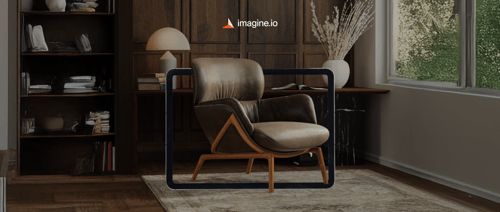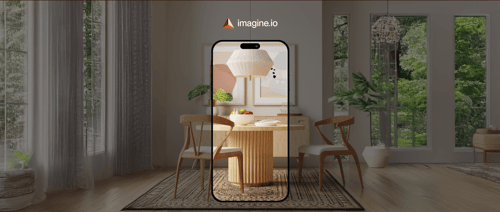The eCommerce battlefield is fierce, where a single image can tip the scales between a sale and a scroll-past. For furniture, home décor, and textile brands, the pressure to deliver flawless, marketplace-ready visuals across platforms like Amazon, Wayfair, and Shopify is unrelenting. High-quality product imagery drives purchase intent by building consumer trust, much like Apple's meticulously curated product pages that immerse buyers in a seamless brand experience. Yet, traditional visual production laden with costly photoshoots and endless revisions is buckling under the demands of multi-channel retail. A unified pipeline, powered by AI and 3D technology, offers a smarter path: streamlined workflows, slashed costs, and visuals that boost conversions by over 500%. This is how brands are scaling their visuals to dominate eCommerce marketplaces.
Trends Reshaping Multi-Marketplace Visuals
Marketplaces are tightening the screws. Amazon, Walmart, and Wayfair now enforce rigorous standards for images, videos, and augmented reality (AR) assets, demanding pixel-perfect precision to stand out in crowded digital aisles. Consumers, too, are raising expectations, craving interactive experiences like 360-degree spins or configurators that let them visualize a chair in their living room. The eCommerce photography market, valued at $3.2 billion in 2023, is on track to hit $12.4 billion by 2033, growing at a 13.4% CAGR from 2025 to 2033. This surge reflects the boom in online shopping and the need for compelling visuals to capture buyer attention across industries like fashion and home goods.
AI is the engine behind this transformation. Advancements in artificial intelligence and machine learning are automating image processing, slashing production times while maintaining quality. The digital image processing market, worth $93.27 billion in 2024, is projected to reach $378.71 billion by 2034, with a 15.42% CAGR. By automating tasks like background removal and marketplace-specific formatting, AI empowers brands to scale visuals efficiently, meeting the demands of platforms and social media channels like Instagram and LinkedIn.
Real-World Success With Unified Pipelines
Picture a furniture brand launching a 1,000-SKU collection across multiple marketplaces. Traditionally, this would mean months of photoshoots, sample shipping, and platform-specific tweaks. With a unified pipeline, the game changes. A single 3D model uploaded to a platform like imagine.io can generate photorealistic images, videos, and AR assets in days. One home décor brand used this approach to deploy visuals across Amazon, Shopify, and their own site, cutting production time by 60% while maintaining consistent quality.
AR is a standout use case. A textile brand recently launched an AR-enabled line, letting customers preview rugs in their homes via a mobile app. By centralizing 3D assets in a unified pipeline, the brand produced marketplace-compliant visuals and interactive experiences simultaneously, meeting tight deadlines without compromising brand coherence. These examples highlight how unified pipelines empower brands to scale rapidly while delivering immersive customer experiences.
Case Study: Furniture Brand Breakthrough
A mid-sized furniture brand faced a daunting task: launching a seasonal collection across six marketplaces. Using imagine.io's cloud-based platform, they uploaded 3D models and generated thousands of assets images, 360 spins, and configurators in under a week. The result? A seamless rollout that met each platform's specs and boosted click-through rates by 30%.
AR-Powered Home Décor Launches
A home décor brand leveraged AR to accelerate product launches. By using a unified pipeline, they created AR-ready visuals for Wayfair and their DTC site, enabling customers to visualize products in real-world settings. This cut launch timelines by 40% and increased engagement on social platforms like YouTube and Facebook.
Navigating the Challenges of Visual Scaling
Scaling visuals across marketplaces is fraught with obstacles. Each platform demands unique formats Amazon insists on white backgrounds, while Wayfair favors lifestyle shots. This fragmentation creates a logistical nightmare, forcing brands to juggle multiple workflows. Traditional production compounds the problem, requiring physical samples, studio bookings, and iterative reshoots that delay launches and inflate costs.
Cost is a major hurdle. A single photoshoot for a furniture line can cost $50,000 or more, and high-SKU catalogs multiply that expense. Some brands hesitate to adopt platforms like imagine.io, citing subscription costs over project-based work or the complexity of custom pricing. Others worry about integrating new tools into established agency workflows. But clinging to outdated methods is a losing strategy in a market where speed and scale are paramount.
Format Fragmentation Woes
Marketplace requirements vary wildly. A sofa image that works on Shopify might fail Amazon's compression standards. Without a unified system, brands waste time reformatting assets, risking inconsistent visuals that erode trust.
Manual Production Bottlenecks
Traditional workflows are slow and labor-intensive. Shipping samples, scheduling shoots, and waiting for edits can delay launches by weeks, leaving brands vulnerable to faster competitors.
Why Unified Pipelines Win
A unified pipeline dismantles these barriers. It starts with a centralized 3D asset library a single hub for generating all visual outputs. Upload a model to imagine.io, and its cloud-rendering engine produces unlimited assets in minutes, from high-res images to interactive configurators. Unlike competitors focused on niche solutions, imagine.io's all-in-one platform delivers every visual type with photorealistic quality that rivals traditional shoots. Experts can't tell the difference, with studies showing imagine.io's AI-generated assets are indistinguishable from real photos.
Consistency is a key advantage. A unified pipeline ensures visuals align across channels, whether on a DTC site, Amazon, or a retail partner's portal. For brands in hubs like New York, Los Angeles, or High Point centers of furniture and décor innovation this consistency builds trust and strengthens market presence.
Scalability Without Limits
imagine.io's subscription model allows brands to generate unlimited assets, perfect for high-volume catalogs. A single model can produce thousands of variations, meeting diverse marketplace needs without added costs.
Brand Cohesion Across Channels
Unified pipelines maintain visual harmony. A rug's color and texture look identical on Walmart, Shopify, or Instagram, reinforcing brand identity and driving customer confidence.
The Business Case for Streamlined Visuals
The impact is undeniable. Unified pipelines cut launch cycles by weeks, letting brands hit the market faster. Cost savings are dramatic imagine.io's platform reduces visual production expenses by up to 70% compared to traditional methods. Most compelling is the sales uplift: optimized visuals, including 360 spins and configurators, can boost eCommerce conversions by over 500%. For brands competing in crowded marketplaces, this is a game-changer.
Beyond numbers, unified pipelines free up creative bandwidth. Brands can experiment with new visuals or launch limited-edition products without logistical headaches, giving them an edge in fast-moving markets like Dallas or Las Vegas.
Faster Market Entry
By streamlining production, brands can launch products in days, not months, seizing market opportunities before competitors.
Cost Efficiency at Scale
Traditional photoshoots drain budgets. Unified pipelines offer predictable, subscription-based pricing that scales with SKU counts, saving up to 70%.
Looking Ahead: The Future of Visual Production
AI is redefining creative workflows, balancing automation with brand-specific customization. Platforms like imagine.io allow brands to tailor visuals while leveraging cloud efficiency. The future promises even more disruption, with virtual showrooms and metaverse commerce demanding richer, more interactive assets. Brands that adopt scalable 3D platforms now will lead the pack.
Experts urge brands to standardize 3D assets, align visual strategies with multi-marketplace goals, and embrace AI-driven tools. Social media LinkedIn, Instagram, YouTube remains a powerful amplifier, as seen with brands like Ruggable and Kohler, who leverage these channels to showcase stunning visuals.
A Memorable Conclusion
In the high-stakes world of eCommerce, visuals are the currency of trust and conversion. A unified pipeline, powered by AI and 3D technology, is no longer optional it's the backbone of competitive advantage. For furniture, home décor, and textile brands in markets like Chicago, Canada, or Las Vegas, the choice is clear: streamline visual production, cut costs, and deliver experiences that captivate buyers. The future belongs to those who scale smartly, and with tools like imagine.io, that future is now.
Frequently Asked Questions
How can AI and 3D technology reduce eCommerce product photography costs?
AI-powered unified pipelines like imagine.io can reduce visual production expenses by up to 70% compared to traditional photoshoots. Instead of costly studio sessions that can cost $50,000+ for furniture lines, brands upload a single 3D model and generate unlimited photorealistic images, 360° spins, and AR assets in minutes. This eliminates the need for physical samples, studio bookings, and multiple reshoots across different marketplace requirements.
What are the main challenges of selling products across multiple eCommerce marketplaces?
The biggest challenge is format fragmentation each platform has unique visual requirements (Amazon demands white backgrounds while Wayfair prefers lifestyle shots). Traditional production creates bottlenecks with lengthy photoshoots, sample shipping, and platform-specific tweaks that can delay launches by weeks. Brands also struggle with maintaining visual consistency across channels while managing the high costs of producing marketplace-compliant assets for high-SKU catalogs.
How much can optimized product visuals increase eCommerce conversion rates?
Optimized visuals including 360-degree spins and product configurators can boost eCommerce conversions by over 500%. High-quality product imagery drives purchase intent by building consumer trust, and unified visual pipelines ensure consistent, professional-grade assets across all channels. Brands using streamlined visual production also see 30% increases in click-through rates and can launch products in days rather than months, capturing market opportunities faster than competitors.
Disclaimer: The above helpful resources content contains personal opinions and experiences. The information provided is for general knowledge and does not constitute professional advice.
You may also be interested in: Future-Proofing Mattress Retail with imagine.io's 3D Visualization
Struggling with expensive, outdated product visuals that slow down your creative process and stunt eCommerce growth? imagine.io's AI-powered platform empowers furniture, home décor, and textile brands to effortlessly produce striking 3D images, immersive videos, AR experiences, and interactive configurators. Cut production costs up to 70%, boost conversions 5X, speed up prototyping, and supercharge your online sales. Ready to elevate your product visuals and captivate customers? Book a demo with imagine.io today!
Powered by flareAI.co




.png?width=500&name=How%20to%20Add%20a%203D%20Product%20Configurator%20to%20Your%20WordPress%20Website%20(Complete%20B2B%20Guide).png)
















%20(1).png?width=500&name=Why%20Exploded%20Mattress%20Views%20Matter%20(And%20How%20to%20Generate%20Them)%20(1).png)
.png?width=500&name=Best%20Shopify%20Product%20Configurator_%20How%20to%20Choose%20the%20Right%20One%20(2).png)
.png?width=500&name=Why%20Exploded%20Mattress%20Views%20Matter%20(And%20How%20to%20Generate%20Them).png)



.png?width=500&name=Best%20Shopify%20Product%20Configurator_%20How%20to%20Choose%20the%20Right%20One%20(1).png)







.png?width=500&name=How%203D%20Rendering%20Can%20Make%20or%20Break%20Your%20Industrial%20Design%20Pitch%20(1).png)








%20with%20Digital%20Twins%20and%203D%20Visualization.png?width=500&name=Optimizing%20Your%20Digital%20Asset%20Management%20(DAM)%20with%20Digital%20Twins%20and%203D%20Visualization.png)




.png?width=500&name=Styling%20Home%20Decor%20for%202025_%20From%20Global%20Influences%20to%20Playful%20Personalization%20(1).png)
